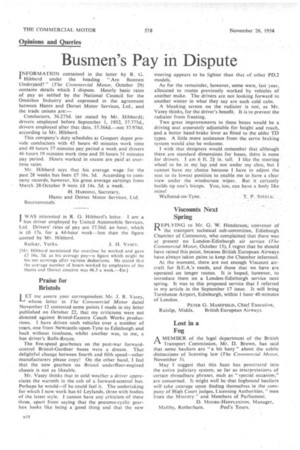Busmen's Pay in Dispute
Page 52

If you've noticed an error in this article please click here to report it so we can fix it.
INFORMATION contained in the letter by R. G.
Hibberd under the heading "Are Busmen Underpaid?" (The Commercial Motor, October 29) contains details which I dispute. Hourly basic rates of pay as settled by the National Council for the Omnibus Industry and expressed in the agreement between Hants and Dorset Motor Services, Ltd., and the trade unions are:—
Conductors, 36.273d. (as stated by Mr. Hibberd); drivers employed before September 1, 1952, 37.773d., drivers employed after that date, 37.364d.—not 37.974d. according to Mr. Hibberd.
This company's duty schedules at Gosport depot provide conductors with 45 hours 40 minutes work time and 49 hours 57 minutes pay period a week and drivers 46 hours 19 minutes work time and 50 hours 51 minutes pay period. Hours worked in excess are paid at overtime rates.
Mr. Hibberd says that his average wage for the past 28 weeks has been £7 16s.. 5d. According to company records, however, his gross average earnings from March 28-October 9 were £8 14s. 54. a week.
H. HARDING, Secretary, I WAS interested in R. G. Hibberd's letter. I am a I bus driver employed by United Automobile Services, Ltd. Drivers' rates of pay are 37.36d. an hour, which is £.6 I7s, for a 44-hour week—less than the figure quoted by Mr. Hibberd. • R edcar, Yorks. J. H. VASEY.
[Mr. Hibberd mentioned the overtime he worked and gave 16s. 5d. as his average pay—a figure which might be his net earnings after various deductions. He stated th.it the average number of hours worked by employees of the Hants and Dorset concern was 46.3 a week.—ED.]
Praise for Bristols
LET me assure your correspondent Mr. J. R. Vasey,
whose letter in The Commercial Motor dated November 12 contested some points I made in my letter published on October 22, that my criticisms were not directed against Bristol-Eastern Coach Works productions. 1 have driven such vehicles over a number of years, one from Newcastle-upon-Tyne to Edinburgh and back without tiredness, whilst another was, to me, a bus driver's Rolls-Royce. The five-speed gearboxes on the post-war forwardcontrol Bristol-Gardner buses were a dream. That delightful change between fourth and fifth speed—other manufacturers please copy! On the other hand, I feel that the new gearbox on Bristol underfloor-engined chassis is not as likeable.
Mr. Vasey thinks that in cold weather a driver appreciates the warmth in the cab of a forward-control bus. Perhaps he would—if he could feel it. The undertaking for which I now work has 61 Leylands, three with bodies of the latest style. I cannot have any criticism of these three, apart from saying that the pneumo-cyclic gearbox looks like being a good thing and that the new steering appears to be lighter than that of other PD.2 models.
As for the remainder, however, some were, last year, allocated to routes previously worked by vehicles of another make. The drivers are not looking forward to another winter in what they say are such cold cabs. A blanking screen on the radiator is not, as Mr. Vasey thinks, for the driver's benefit. It is to prevent the radiator from freezing. • Two great improvements to these buses would be a driving seat separately adjustable for height and reach, and a better hand-brake lever as fitted to the older TD types. A little more assistance from the servo braking system would also be welcome. I wish that designers would, renumber that although there are standard dimensions for buses, there is none • for drivers. I am 6, ft. 2 in. tall. I like the steering • wheel to be in my lap and not under my chin, but I cannot have my choice because I have to adjust the seat to its lowest position to .enable me to_have a clear view under the windscreen wiper. But it certainly builds up one's biceps. You, too, can have a body like mine! •
Wallsend-on-Tyne. T. P. STEELE:
Viscounts Next Spring
REPLYING to Mr. G. W. Henderson, convenor of the transport technical sub-committee, Edinburgh Chamber of Commerce, who complained-that there was at present no London-Edinburgh air service (The Commercial Motor, October 15), I regret that he should have raised this point, because British European Airways have always taken pains to keep the Chamber informed.
At the moment, there are not enough Viscount aircraft for B.E.A.'s needs, and those that we have are operated on longer routes. It is hoped, however, to introduce them on a London-Edinburgh service next spring. It was to this proposed service that I referred in my article in the September 17 issue. It will bring Turnhouse Airport, Edinburgh, within 1 hour 40 minutes of London.
PETER G. IVIASEFIELD, Chief Executive,
Ruislip, Middx. British European Airways.
Lost in a Fog
AMEMBER of the legal department of the British Transport Commission, Mr. D. Brown, has said that some hauliers are "a bit hazy" about the subtle distinctions of licensing law (The Commercial Motor, November 5).
May I suggest that this haze has penetrated into the entire judiciary system, so far as interpretations of certain threadbare phrases, such as "special. occasion," are concerned. It might well be that fogbound hauliers will take courage upon finding themselves in the company of High Court judges, Licensing Authorities. "men from the Ministry" and Members of Parliament. D. MOORE-HEPPLESION, Manager, Maltby, Rotherham. Peel's Tours.




























































































